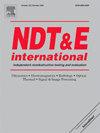增材制造金属零件孔隙率预测的迁移学习方法
IF 4.5
2区 材料科学
Q1 MATERIALS SCIENCE, CHARACTERIZATION & TESTING
引用次数: 0
摘要
我们在合成数据集上实现了物理信息神经网络(PINN)预训练,利用实验超声脉冲回波数据量化增材制造AlSi10Mg组件的分布孔隙度。提出的PINN框架直接处理原始超声数据来估计体积孔隙度和平均孔径。由于神经网络(NN)模型对数据的要求很高,所以训练最初是在通过有限元模拟生成的数据集上进行的。然后使用其中的一部分再训练后,将预训练好的PINN转移到实验数据中。PINN集成了基于Sayers散射模型的物理约束,该模型将波速与孔隙度和孔隙半径联系起来。值得注意的是,模型中的两个物质相关常数被视为可学习的参数,在训练过程中收敛到它们的真实值。结果表明,PINN具有较高的预测精度,体现在较高的r2分数和较低的rmse上。此外,通过不同的训练集大小进行性能评估研究;在所有训练集大小上,PINN始终优于相应的数据驱动模型(没有物理约束),随着训练集大小的减小,其优势变得更加明显。我们的研究结果表明,即使在训练的标记数据量有限的情况下,由波动物理学通知的前馈神经网络也可以从原始超声波响应中准确地量化样品中的孔隙率和孔隙半径。本文章由计算机程序翻译,如有差异,请以英文原文为准。
A transfer learning approach to the prediction of porosity in additively manufactured metallic components
We implement a physics-informed neural network (PINN) pretrained on a synthetic dataset to quantify distributed porosity in additively manufactured AlSi10Mg components using experimental ultrasonic pulse-echo data. The proposed PINN framework directly processes raw ultrasonic data to estimate volumetric porosity and average pore size. Due to the significant data requirements of neural network (NN) models, training is initially conducted on a dataset generated through finite element simulations. Then the pretrained PINN is transferred to the experimental data after using a portion of them for retraining. The PINN integrates physics constraints based on Sayers scattering model, which relates wave speed to porosity and pore radius. Notably, the two material-dependent constants in the model are treated as learnable parameters, which converge to their true values during the training process. Results indicate that the PINN achieves superb prediction accuracy, reflected in high r2-scores and low RMSEs. Additionally, a performance evaluation study is conducted by varying training set sizes; the PINN consistently outperforms the corresponding data-driven model (without physics constraint) across all training set sizes, with its advantage becoming more pronounced as the training set size decreases. Our findings suggest that a feed-forward neural network informed by wave physics can accurately quantify the porosity and pore radius within our samples from their raw ultrasonic responses even when the amount of labelled data for training is limited.
求助全文
通过发布文献求助,成功后即可免费获取论文全文。
去求助
来源期刊

Ndt & E International
工程技术-材料科学:表征与测试
CiteScore
7.20
自引率
9.50%
发文量
121
审稿时长
55 days
期刊介绍:
NDT&E international publishes peer-reviewed results of original research and development in all categories of the fields of nondestructive testing and evaluation including ultrasonics, electromagnetics, radiography, optical and thermal methods. In addition to traditional NDE topics, the emerging technology area of inspection of civil structures and materials is also emphasized. The journal publishes original papers on research and development of new inspection techniques and methods, as well as on novel and innovative applications of established methods. Papers on NDE sensors and their applications both for inspection and process control, as well as papers describing novel NDE systems for structural health monitoring and their performance in industrial settings are also considered. Other regular features include international news, new equipment and a calendar of forthcoming worldwide meetings. This journal is listed in Current Contents.
 求助内容:
求助内容: 应助结果提醒方式:
应助结果提醒方式:


